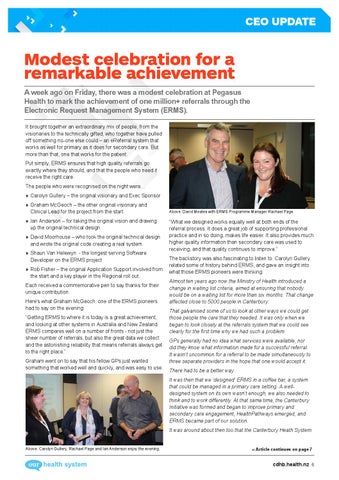CEO Update
Modest celebration for a remarkable achievement A week ago on Friday, there was a modest celebration at Pegasus Health to mark the achievement of one million+ referrals through the Electronic Request Management System (ERMS). It brought together an extraordinary mix of people, from the visionaries to the technically gifted, who together have pulled off something no-one else could – an eReferral system that works as well for primary as it does for secondary care. But more than that, one that works for the patient. Put simply, ERMS ensures that high quality referrals go exactly where they should, and that the people who need it receive the right care. The people who were recognised on the night were… »» Carolyn Gullery – the original visionary and Exec Sponsor »» Graham McGeoch – the other original visionary and Clinical Lead for the project from the start »» Ian Anderson – for taking the original vision and drawing up the original technical design »» David Moorhouse – who took the original technical design and wrote the original code creating a real system. »» Shaun Van Helewyn - the longest serving Software Developer on the ERMS project »» Rob Fisher – the original Application Support involved from the start and a key player in the Regional roll out. Each received a commemorative pen to say thanks for their unique contribution. Here’s what Graham McGeoch, one of the ERMS pioneers had to say on the evening: “Getting ERMS to where it is today is a great achievement, and looking at other systems in Australia and New Zealand ERMS compares well on a number of fronts - not just the sheer number of referrals, but also the great data we collect and the astonishing reliability that means referrals always get to the right place.” Graham went on to say that his fellow GPs just wanted something that worked well and quickly, and was easy to use.
Above: David Meates with ERMS Programme Manager Rachael Page.
“What we designed works equally well at both ends of the referral process. It does a great job of supporting professional practice and in so doing, makes life easier. It also provides much higher quality information than secondary care was used to receiving, and that quality continues to improve.” The backstory was also fascinating to listen to. Carolyn Gullery related some of history behind ERMS, and gave an insight into what those ERMS pioneers were thinking: Almost ten years ago now the Ministry of Health introduced a change in waiting list criteria, aimed at ensuring that nobody would be on a waiting list for more than six months. That change affected close to 5000 people in Canterbury. That galvanised some of us to look at other ways we could get those people the care that they needed. It was only when we began to look closely at the referrals system that we could see clearly for the first time why we had such a problem. GPs generally had no idea what services were available, nor did they know what information made for a successful referral. It wasn’t uncommon for a referral to be made simultaneously to three separate providers in the hope that one would accept it. There had to be a better way. It was then that we ‘designed’ ERMS in a coffee bar, a system that could be managed in a primary care setting. A welldesigned system on its own wasn’t enough, we also needed to think and to work differently. At that same time, the Canterbury Initiative was formed and began to improve primary and secondary care engagement, HealthPathways emerged, and ERMS became part of our solution. It was around about then too that the Canterbury Heath System
Above: Carolyn Gullery, Rachael Page and Ian Anderson enjoy the evening.
›› Article continues on page 7
cdhb.health.nz 6
